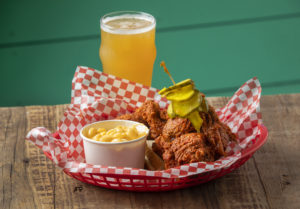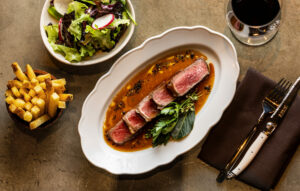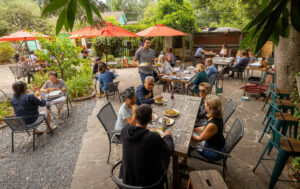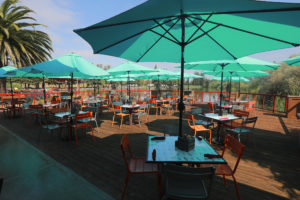 Ever wonder what happens behind the kitchen doors at your favorite restaurant? Confused about tipping protocol or whether it’s okay to ask for something off-menu? How do you know if a restaurant is sanitary or what to do if you find a bug in your food? BiteClub gets the down and dirty from local chefs Josh Silvers of Syrah Bistro, Mark Malicki of Cafe Saint Rose, Mark Dierkhising of Dierk’s Parkside Cafe and Betsy Fischer, culinary educator, consultant and manager of the Santa Rosa Junior College Cafe, on what’s really happening behind the scenes.
Ever wonder what happens behind the kitchen doors at your favorite restaurant? Confused about tipping protocol or whether it’s okay to ask for something off-menu? How do you know if a restaurant is sanitary or what to do if you find a bug in your food? BiteClub gets the down and dirty from local chefs Josh Silvers of Syrah Bistro, Mark Malicki of Cafe Saint Rose, Mark Dierkhising of Dierk’s Parkside Cafe and Betsy Fischer, culinary educator, consultant and manager of the Santa Rosa Junior College Cafe, on what’s really happening behind the scenes.
What happens when I send food back to the kitchen?
It depends why you’ve sent it back and if you’ve eaten off the plate. If your meat isn’t cooked through (or to your degree of done-ness), the kitchen will likely do a “re-fire” which means throwing it back on the grill to cook it more. This is a matter of some controversy, because if you’ve stuck your fork into it and taken a few bites, it’s a health issue to put it back on the grill. Usually it’s the call of the chef.
If you’ve sent it back for another reason, most likely you’ll get an entirely new entrée. Again, it depends on how much you’ve eaten and whether you have a legit gripe or are just being stinky. Obviously eating half your dinner and then sending it back is pretty uncool.
What if there’s a bug in my food?
It’s not that uncommon to find a little critter in organic salad greens, chefs tell me. Usually they’re small and harmless. It’s not necessarily a reflection on the sanitary conditions of the restaurant. Finding bugs (especially roaches) or other unwanted yuckiness should definitely be reported to management and the food sent back.
How do I know if the place I’m eating is sanitary?
In Southern California, restaurants are given a grade “A”, “B” or “C” that they are required to post on their door so patrons know the score. There’s been considerable industry push-back against this in Northern California. Want to know if your fave spot makes the grade? The Sonoma County Department of Health Services maintains current violations for all restaurants at food.sonoma-county.org. You can also click on the “Food Safety Recognition of Excellence” winners to see who’s received outstanding food safety records.
Will they spit in my food if I send it back?
I can’t say this never happens. But it doesn’t occur, as movies might want us to think, all that often. Insiders say they’ve never witnessed the “special saucing” of a customer it in years of restaurant service at higher end restaurants. There’s too much on the line and its juvenile. That doesn’t mean bad customers always have the last word. A few chefs I talked to aren’t shy about having a straightforward dialogue with particularly difficult patrons.
The customer is always right, right?
Not so much anymore. Most chefs say they want to make people happy and are willing to bend over backwards to accommodate guests if they can. They know that one unhappy person can tell dozens of their friends and really hurt business. But if they think you’re just being a royal pain, chances are you won’t get the royal treatment. Laws about employee harassment paired with the restaurant’s need to keep good staff mean that cranky complainers may be asked to leave. Permanently.
How do I get the best service?
Be nice to people. The number one gripe waiters have: Rude people.
What happens to that bread I left behind?
It gets thrown away. A few restaurants have composting programs and feed the scraps to animals. According to health codes, it cannot be served to any human.
How much should I tip?
Currently 18-20% is standard.
Who gets the tip?
Many restaurants pool tips, meaning that all the floor staff get a percentage – from hostess to server to busser. Keep that in mind when it comes to leaving behind a gratuity. Even if your waiter didn’t do a great job, if you stiff them you’re also stiffing a whole bunch of other folks. If you’ve had bad service, you’re not obligated to leave anything, but it’s a good rule of thumb to leave something and let the management know you’re unhappy rather than just leaving without tipping.
I hate it/love it when waiters give me their opinion about the menu, tell me their name and explain specials in detail.
There are two distinct schools of thought about interacting with waitstaff. Mine happens to be asking a lot of questions and expecting well-trained answers. At a good restaurant, staff will have tasted everything on the menu and been briefed on its preparation and ingredients. I find this helpful information. I also like hearing their opinion (if asked), even if their taste isn’t the same as mine. I tip better if my waiter is helpful. I tip less if, when I ask, “What’s especially good today?” I get the answer, “Everything.” That’s a bold-faced lie and frankly, lazy.
I also enjoy knowing their name, and having the specials described in detail. That shows me they take pride in their job and helps me make an informed decision. I also think that having a polite interaction helps them know what you might like and to better accommodate your taste. If you dislike social interactions like these, you’re in the other school. And frankly, you’re grumpy.
What’s the best way to eat alone in a restaurant?
Most restaurants are happy to accommodate “tables for one”, though out of respect for their flow, its considerate to sit at the bar or a small table rather than demanding a larger table. I actually enjoy sitting at the bar, because you’ll often be able to strike up a conversation with the bartender or others dining alone. You should never feel uncomfortable or rushed. In fact, some restaurants say they try extra hard to make single diners feel welcome.
Is it appropriate to request a “chefs table” or try to talk to the chef?
Keep in mind that the chefs are usually very busy during service, but if you sit at the bar near an open kitchen (there are open kitchens at Syrah and Zin) you can sometimes chat with them while they’re working. Just be courteous of their time and focus. If you’d like to compliment the chef, the best route is to let your server know you’d like to have a moment to thank them before you leave. Often the chef will come out for a brief hello when he or she has a moment. Who doesn’t like a pat on the back? Don’t feel slighted, however, if he’s in the weeds and can’t come out.
I’m allergic to certain foods. Why can’t they accommodate me?
These days, it seems like pretty much everyone has issues with certain foods – whether its gluten, salt, meat, nuts or, whatever. And that’s totally fine, but don’t expect the line to come to a screetching halt just to deal with your issues. What you should expect is courtesy, however. Most restaurants – from Cyrus to Jack in The Box – have dealt with this numerous times and have experience creating dishes on the fly. Out of courtesy (again, that word!), if you’ve got hard-and-fast food allergies, call ahead and let them know, especially if they’re extensive. Usually they’ll let you know how they can best accommodate you and everyone can plan ahead.
I’m vegetarian. I’m vegan.
Depending on whom you ask, this is either becoming less of an issue –or more. Good chefs are crystal clear that adding chicken stock to their rice or soup means it isn’t okay for vegetarians and adding cream to anything means it ain’t vegan. Many menus offer a clear-cut meat/dairy-free item. Thing is, not everyone gets it or cares. So when eating out, consider where you’re at. If you’re at a steakhouse, there may be fewer options than, say, an Asian restaurant or anywhere in Sebastopol. Again, be polite rather than belligerent if your wait staff need to ask questions in the kitchen. Good restaurants will strive to find something tasty for you.
I don’t like (insert issue). What should I do?
When you’re ordering, ask your server if you can get the dish without (olives, pickles, etc.) Sometimes it’s an easy thing for the kitchen to deal with. Sometimes it isn’t, so be prepared to order something else. Sometimes food is prepped beforehand and can’t be altered. If you’re just being high-maintenance, consider the fact that you’re creating serious kitchen issues and slowing down everyone’s meal.
Is it okay to ask for something off the menu?
Again, use good judgment. Usually its fine to ask for something that’s within the scope of what ingredients the restaurant has on hand and doesn’t require a lot of extra effort in the kitchen. Just keep in mind that you’re putting the kitchen at a disadvantage if they have to break their rhythm for your special order. Grilled cheese for a kiddo is probably no problem. Asking the chef to put together an entirely new entrée on the fly is a bit more challenging.
When’s the best day to order fish?
It used to be that Monday and Tuesday were bad days to order fish because the deliveries came on Thursday or Friday. Not so much anymore. Most restaurants get their produce and meat deliveries on an almost daily basis.
What’s with “specials”? Are they just leftovers with a fancy name?
Not usually. Usually specials reflect a good value from provisioners or a seasonal treats (ie: mushrooms or truffles). For the most part, they’re a good bet and tend to reflect the creativity of the chef. Don’t be afraid to ask about prices if the server doesn’t mention them.
What’s with corkage?
This is a can of worms. Most restaurants charge between $10 and $20(!) to open a bottle of wine you bring into their restaurant. Their defense: You’re using their stemware, it takes staff time to pour the wine, and they’re losing out on a potential sale. Wine markups are a high margin profit for a restaurant. According to SRJC Cafe’s Betsy Fischer, corkage isn’t always justified. “It’s a revenue source that’s been around forever. Most restaurants are unwilling to give it up. But I’m not for corkage. Learn how to do wine by the glass and teach your staff to make this an everyday part of what you sell,” she said.
Does food get prepared in advance and just micro-waved or reheated when I order it?
Yes and no. At good restaurants, almost everything is made to order. Sure, they’ll dice and chop vegetables in advance, maybe even par-boil or braise something slow-cooking meats or veggies, but for the most part, your entrees are made to order. Desserts are a different story (most must be baked well in advance). Lower-end restaurants work with frozen or pre-prepared dishes that need only to be heated and assembled by minimally-trained staff onsite. That’s a big part of what you’re paying f
or — skilled staff using fresh ingredients vs. not so much.
Salted vs. Unsalted butter
Unsalted. And never ice cold or mushy soft. And please, no weird rosettes.
What happens to leftovers?
Like the bread, nothing that’s been on a customer’s plate is served to humans. Sometimes, however, a restaurant will have extra food that’s never left the kitchen. This is often served at “family meal”, a meal given to staff before or after service.
When’s the best time to eat out?
Go before or after the 7:30pm rush. Also, eating during the week or a quieter night may give you access to less rushed service. Friday and Saturday nights are the busiest, obviously. Many restaurants are closed Monday and Tuesday.
More questions? Let me know!









